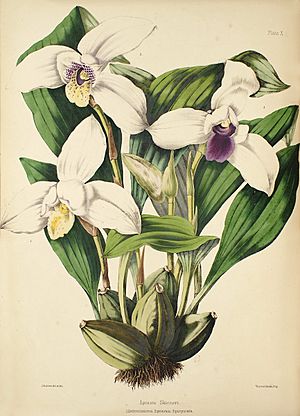Lycaste skinneri facts for kids
Quick facts for kids Lycaste skinneri |
|
|---|---|
 |
|
| Illustration of Lycaste skinneri by Walter Hood Fitch | |
| Scientific classification | |
| Genus: |
Lycaste
|
| Species: |
skinneri
|
| Synonyms | |
|
|
The Lycaste skinneri, also known as Lycaste virginalis, is a beautiful type of orchid. It grows on other plants, like trees, but it doesn't harm them. This kind of orchid is found in southern Mexico, Guatemala, El Salvador, and Honduras. It usually lives in places about 1,650 meters (about 5,400 feet) above sea level.
Contents
What Does the Lycaste Skinneri Orchid Look Like?
This orchid has thick parts called pseudobulbs. Long leaves grow from these pseudobulbs. The flowers are usually triangular and grow one by one from the base of the newest pseudobulb. Each flower can be quite large, measuring between 10 and 15 centimeters (about 4 to 6 inches) across.
Flower Colors and Blooming Time
The flowers of the Lycaste skinneri orchid come in many colors. Some are completely white, especially a type called the Alba variety. Others can be different shades of pink or even lavender. Because of their pure colors, these flowers are often used to create new types of Lycaste hybrid orchids.
These orchids bloom, or open their flowers, between November and April. The best time to see them in full bloom is usually in late January and early February. A healthy, grown-up plant can produce between 4 and 12 flowers during its blooming season. Each flower can last for 6 to 8 weeks.
How Does This Orchid Reproduce?
The Lycaste skinneri is a hermaphrodite plant. This means it has both male and female parts in the same flower. It can produce millions of tiny seeds. These seeds grow inside a fruit that looks like a capsule.
However, these seeds need special help to grow. They can only sprout if a specific type of fungus is present. Because of this special need, the Lycaste skinneri orchid is quite rare in the wild. In Guatemala, it is even against the law to sell or trade these plants to protect them. This is called commercialization.
Where Does the Lycaste Skinneri Orchid Live?
The Lycaste skinneri orchid lives in the wet forests of Mexico, Guatemala, El Salvador, and Honduras. It is most common in Guatemala. It prefers to live about 1,650 meters (about 5,400 feet) above sea level. At this height, it avoids very hot temperatures in the summer and very cold temperatures in the winter.
Ideal Living Conditions
These orchids thrive in places with lots of clouds close to the ground. This cloud cover helps keep the air moist, even during the dry season. They usually grow on the branches of strong, woody trees. They pick spots where they can get just the right amount of light.
The Lycaste skinneri is very sensitive to temperature changes. It likes temperatures to be around 27 °C (80 °F) during the day and drop to about 18 °C (64 °F) at night. The perfect amount of moisture in the air, called relative humidity, for this orchid is between 50 and 70 percent.
Guatemala's Special Flower
This beautiful orchid is also known as the monja blanca, which means "white nun" in Spanish. It is the national flower of the Republic of Guatemala.
How It Became a National Symbol
In 1933, a woman named Leticia M. de Southerland suggested that the Lycaste skinneri alba orchid should be Guatemala's national flower. She was the president of an International Exhibition of Flowers held in Miami Beach, Florida.
The president of Guatemala at the time, General Jorge Ubico, asked experts for their opinion. These experts, including Ulises Rojas and Mariano Pacheco H., and groups like the National Library, agreed. They thought the flower was very beautiful and rare. So, on February 11, 1934, the president officially declared the monja blanca as the national flower of Guatemala.
Protecting the Monja Blanca
Later, on August 9, 1946, during the time of President Juan Jose Arevalo, a new rule was made. This rule was created to protect the monja blanca from disappearing in Guatemala. It made it illegal to collect or export the orchid.
This rule was updated on June 4, 1947. The ban was extended to include the pseudobulbs and flowers of the monja blanca. It also covered all other types of orchids in Guatemala. In 1997, when new 50-cent coins were made in Guatemala, the monja blanca was chosen to be featured on one side of the coin.
See also
 In Spanish: Monja Blanca para niños
In Spanish: Monja Blanca para niños

